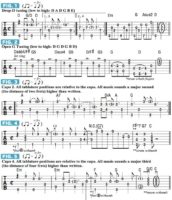
Celebrating 50 Years of Jorma Kaukonen’s Fingerpicking Prowess
This column honors Jorma Kaukonen’s half century of contributions to acoustic music.
Renowned for his work in iconic bands like Jefferson Airplane and Hot Tuna, Kaukonen’s discography also boasts a dozen solo albums. And he runs his own guitar camp (Fur Peace Ranch), which hosts ace artist-instructors, such as Tommy Emmanuel and Tony Rice.
Schooled in the styles of Rev. Gary Davis and other country-blues pioneers, Kaukonen uses a thumbpick, along with fingerpicks on his middle and index fingers (“bare” fingerpicking will suffice for the following examples). Let’s delve into this living legend’s vast body of acoustic work.
Shortly after moving to San Francisco in 1962, Kaukonen crossed paths with a bluesy vocal powerhouse named Janis Joplin; their first musical interaction is documented on a bootleg known as The Typewriter Tape (acoustic blues standards and one Joplin original, three years before her recording debut). A “roots” music purist, Kaukonen steered clear of rock and roll until a jam with college pal Paul Kantner’s band swayed him.
At the time, Kaukonen’s nickname was “Blind Thomas Jefferson Airplane,” a moniker later pared down to “Jefferson Airplane,” and, in 1965, appropriated to the band that would lead the Sixties psychedelic rock revolution. Jefferson Airplane’s breakthrough album, Surrealistic Pillow (“Somebody to Love,” “White Rabbit”), was issued in 1967 and included Kaukonen’s drop-D-tuned gem, “Embryonic Journey,” similarly depicted in FIGURE 1. Pick the sixth and fourth strings with alternating thumb strokes, reserving the index and middle fingers to play the melodic line on upper strings.
By 1972, Kaukonen and bassist Jack Casady (whom Jorma had recruited into Jefferson Airplane in 1965) opted to prioritize their side project, Hot Tuna, and left Jefferson Airplane (prompting the “Jefferson Starship“ name change). Hot Tuna released their studio debut, Burgers, that same year. “Water Song,” an acoustic highlight from the album, features Kaukonen doing some challenging fingerpicking in open G tuning and, in bars 1 and 2, using hemiola—a rhythmic device that creates a “three-against-two” phrasing feel, as three-note groups are played in an even eighth-note rhythm—as well as sliding octaves (bar 3), like FIGURE 2.
By 1974, Hot Tuna had morphed into a mostly “electric” act; to serve his acoustic sensibilities, Kaukonen issued his first solo album, Quah, which opens with “Genesis,” akin to FIGURE 3—a bluesy melody on the top three strings, supported by alternating root-fifth bass notes built around A and G chords. (You may recognize this piece from its appearance in the 2014 Johnny Depp film, Transcendence.)
Hot Tuna stopped touring in 1977, but has reconvened numerous times since the early Eighties, issuing their Steady As She Goes CD in 2011.
Throughout, Kaukonen has maintained his acoustic fingerpicking passion, with a dozen solo albums to his credit. We’ll close this lesson with a nod to a pair of cuts from recent Kaukonen discs, “Fur Peace Rag,” from 2007’s Stars in My Crown, and “In My Dreams,” from 2015’s Ain’t in No Hurry (see FIGURES 4 and 5, respectively). Both songs feature Kaukonen’s relentless thumb-picked bass notes and require “thumb-fretted” F chords to facilitate bends or open-string hammer-ons.
Source: www.guitarworld.com












